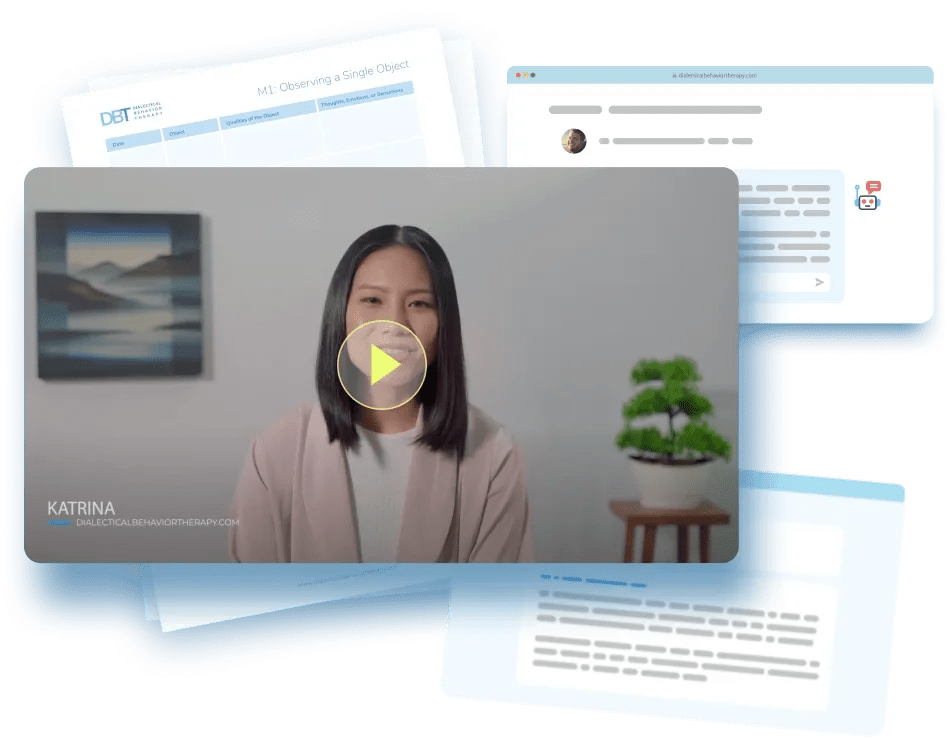Virtual Coach
Work step-by-step through the Distress Tolerance exercise with the virtual coach.
Introduction
When a powerful urge hits, whether it’s to lash out, binge eat, self-harm, drink, or escape, your body and mind can feel hijacked. It’s intense. It’s physical. And it feels like you either act on it right now or explode.
This is where Urge Surfing comes in. It’s a Distress Tolerance skill that teaches you how to sit with that urge without acting on it. Instead of trying to shove the urge down or fight it head-on, you learn to ride it out like a wave. Because here’s the thing about urges: they peak, and then they fade. Always.
Urge Surfing is about being present and mindful with your discomfort, knowing it will pass. It helps you stay in control, not by force, but by awareness. You’re learning how to respond, not react.
Let’s learn how to surf.
Understand Urge as a Wave
Think of an urge like an ocean wave. It builds, it peaks, and then it crashes and fades. Most people act at the peak, when the urge feels unbearable. But the truth is, if you don’t feed the urge by acting on it, it will start to lose strength.
Urge Surfing is not about distracting yourself. It’s about tuning in and noticing what happens in your body and mind without giving in. You’re not trying to change the wave. You’re learning how to ride it skillfully.
5-Minute Urge Surfing
Practice Urge Surfing for 5 minutes.
Do this exercise whenever an urge hits.
Here’s how to practice Urge Surfing when a real urge hits. You can also rehearse this in low-stress moments so you’re more ready when you actually need it.
1. Name the Urge
Begin by identifying what you're feeling the urge to do. Say it out loud or write it down using a clear statement such as, “I have the urge to…” Naming it helps you become more aware of the feeling and gives you space to respond rather than react. For example, “I have the urge to yell at my partner,” or “I have the urge to check my ex’s profile again.” Just being honest with yourself is a powerful first step.
2. Observe the Urge Without Judgment
Once you've named it, turn your attention to how the urge feels in your body. Are you noticing tightness in your chest, heat in your face, or restlessness in your hands? Let yourself feel it fully without trying to fix or avoid it. Think of yourself as a scientist, observing the experience with curiosity rather than drama. Your job isn't to stop the urge, just to notice it.
3. Breathe and Surf
Now imagine the urge as a wave rising and falling. Focus on your breath, steady and slow. Each inhale and exhale helping you stay balanced as the wave passes. Don’t push the feeling away or wrestle with it. Let it come, and let it go. You might visualize it crashing gently onto the shore and slowly receding. Like all waves, this one won’t last forever.
4. Remind Yourself: It Will Pass
As you breathe and ride the wave, gently remind yourself, “This urge is not permanent.” Repeat to yourself: “I am not the urge. I can ride this out. This is hard, but I’ve done hard things before.” To help anchor yourself, set a timer for two to five minutes and commit to staying with the feeling until it fades. Most urges begin to pass within that short window.
Reflect Afterwards
After the urge has passed, or even if you gave in, pause and reflect.
Ask yourself:
- What did I notice about the urge?
- Did it pass?
- What helped me stay with it?
- What would I try differently next time?
Real-Life Example
Scenario: You feel an intense urge to text your ex after seeing a memory pop up on your phone.
Old response: Send the text, feel regret afterward.
Urge Surfing response:
You say: “I have the urge to reconnect.”
You notice: tight chest, fast heart rate, buzzing in your fingers.
You breathe. You imagine the urge rising like a wave.
You tell yourself: “I won’t always feel like this.”
Five minutes pass. The intensity drops.
You decide to journal your feelings instead of texting.
You stayed on the board. You didn’t wipe out. That’s the win.
Worksheets & Virtual Coach
FAQs
Isn't this just distraction in disguise?
No. Urge Surfing is not about avoiding the urge. You’re staying with it on purpose. You're just choosing not to act on it. It’s an application of mindfulness, not distraction.
How is this different from white-knuckling?
White-knuckling is all about resisting and gritting your teeth. Urge Surfing is about accepting the urge is there and letting it do its thing without reacting. You're observing, not battling.
What if I still give in?
That’s okay. This is a skill, not a magic trick. Every time you practice, even if you don’t "succeed," you’re building awareness. That matters. Learn from it and try again next time.
Do urges always fade?
Yes. Every single time. They might come back, sure, but each wave rises and falls. No urge lasts forever. And the more you practice this, the shorter and less powerful the waves become.
Can I combine this with other skills?
Absolutely. Pair Urge Surfing with:
- Mindful breathing
- Cold temperature (ice cube trick from TIPP)
- Wise Mind check-ins
- Half Smile
- Distraction (from ACCEPTS) after you've surfed the wave
Disclaimer
If you have any behavioral health questions or concerns, please talk to your healthcare or mental health care provider. This article is supported by peer-reviewed research and information drawn from behavioral health societies and governmental agencies. However, it is not a substitute for professional behavioral health advice, diagnosis, or treatment.

